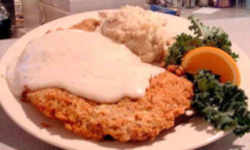
Oklahoma Symbols
Oklahoma State Meal
Fried okra, squash, cornbread, barbecue pork, biscuits, sausage and gravy, grits, corn, strawberries, chicken fried steak, pecan pie, and black-eyed peas.
Adopted in 1988.
Oklahoma designated an official state meal in 1988 consisting of fried okra, squash, cornbread, barbecue pork, biscuits, sausage and gravy, grits, corn, strawberries, chicken fried steak, pecan pie, and black-eyed peas.
The legislature meant the official state meal to reflect Oklahoma's "cultural backgrounds and the state's historical and contemporary agriculture," a laudable goal. But, having enlightened Oklahomans as to their culturally and historically appropriate food items, perhaps it is time to redouble support for Oklahoma farmers and processors and make the official meal a truly "made in Oklahoma" affair.
Oklahoma State Meal
Fried okra, squash, cornbread, barbecue pork, biscuits, sausage and gravy, grits, corn, strawberries, chicken fried steak, pecan pie, and black-eyed peas.
 STATE MEAL. Oklahoma's Official State Meal became one of the State Emblems by virtue of House Concurrent Resolution 1083, approved in 1988 by the Forty-first Legislature. The meal includes an extensive menu reflecting Oklahoma's cultural backgrounds and the state's historical and contemporary agriculture. Meats include barbecued pork, chicken-fried steak, and sausage with biscuits and gravy. Vegetables include fried okra and squash, grits, corn, and blackeyed peas. Breads include cornbread (and biscuits, as above). "Dessert" consists in strawberries and pecan pie. The types, variety, and sheer quantity of foods in the state meal (which can be divided into breakfast, lunch, and dinner) generally typify traditional southern foodways.
STATE MEAL. Oklahoma's Official State Meal became one of the State Emblems by virtue of House Concurrent Resolution 1083, approved in 1988 by the Forty-first Legislature. The meal includes an extensive menu reflecting Oklahoma's cultural backgrounds and the state's historical and contemporary agriculture. Meats include barbecued pork, chicken-fried steak, and sausage with biscuits and gravy. Vegetables include fried okra and squash, grits, corn, and blackeyed peas. Breads include cornbread (and biscuits, as above). "Dessert" consists in strawberries and pecan pie. The types, variety, and sheer quantity of foods in the state meal (which can be divided into breakfast, lunch, and dinner) generally typify traditional southern foodways.
By the early 1800s corn and pork were dietary staples on the southern frontier and after two centuries remained an important part of that region's culinary repertoire. Corn and squash, originally American Indian dietary staples, were breaded with corn meal and fried in pork grease, in southern fashion. Cowpeas, which also may have an American Indian origin but are now considered African American "soul food," were boiled, usually with bacon or fatback. Corn was important, whether boiled on or off the cob, dried, shelled, and ground into corn meal for cornbread and breading, or dried as hominy and ground into grits (or as an ingredient in moonshine liquor). Okra, rolled in corn meal and fried, may originally have been brought to the Western Hemisphere from Africa by seventeenth-century slaves. All of these items remain important in southern cookery, particularly in the upland South and Texas, where many of Oklahoma's nineteenth-century population originated.
Early-day southerners did not generally use wheat flour, but after 1900 milled flour became more available, and biscuits became popular. The Oklahoma meal features biscuits served with gravy, but there is no designation as to whether the gravy is the southern red-eye variety or the white, cream-style concoction commonly served on top of chicken-fried steak.
Pork is also a southern staple. Barbecueing is also typical of the eastern South. In Oklahoma both pork and beef are barbecued, and the selection of pork as the barbecue for the state meal reflects southern, rather than Texas, foodways. While not often eaten in the South, beef was readily available in Texas and Oklahoma where it became a dietary staple. Chicken-fried steak combines the southern tradition of frying with a piece of well-pounded, seasoned Texas beef, rendering edible several otherwise tough cuts of meat. Texas cowhands may have brought this item and cooking method to Oklahoma, where it is now ubiquitous. The late-twentieth-century growth of Oklahoma's commercial hog industry is reflected in the presence of sausage in the State Meal.
The meal finishes with a dessert of fruit and pie. Strawberries (the South's fifth largest crop) and pecans are southern food items as well. They are produced in relatively large quantities in Oklahoma.
Most of the meal's constituents can be found in small restaurants and cafes throughout the state. Into the twenty-first century the Official State Meal continued to reflect the diversity of cultures that is Oklahoma.
BIBLIOGRAPHY: Oklahoma Almanac, 1997-1998 (46th ed; Oklahoma City: Oklahoma Department of Libraries, 1997). Burt Feintuch, "Geography of Foodways," in The Encyclopedia of Southern Culture, ed. Charles Reagan Wilson and William Ferris (Chapel Hill: University of North Carolina Press, 1989). Joe Gray Taylor, "Foodways," in The Encyclopedia of Southern Culture, ed. Charles Reagan Wilson and William Ferris (Chapel Hill: University of North Carolina Press, 1989).
Dianna Everett
Oklahoma Law
Oklahoma's Official State Meal became one of the State Emblems by virtue of House Concurrent Resolution 1083, approved in 1988 by the Forty-first Legislature.

List Official US State Foods






